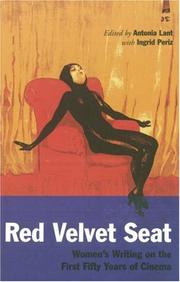| Listing 1 - 4 of 4 |
Sort by
|
Book
ISBN: 0691008280 1400862191 0691600597 9781400862191 9780691055404 0691055408 9780691008288 9780691600598 0691055408 9780691600598 Year: 1991 Publisher: Princeton, New Jersey : Princeton University Press,
Abstract | Keywords | Export | Availability | Bookmark
 Loading...
Loading...Choose an application
- Reference Manager
- EndNote
- RefWorks (Direct export to RefWorks)
The most universal civilian privation in World War II Britain, the blackout possessed many symbolic meanings. Among its complicated implications for filmmakers was a stigmatization of film spectacle--including the display of "Hollywood women," whose extravagant appearance connoted at best unpatriotic wastefulness and at worst collaboration with the enemy. Exploring the wartime breakdown of conventional gender roles on the screen and in the audience, Antonia Lant demonstrates that many British films of the period signaled their national cinematic identity by diverging from the notion of the Hollywood star, the mainstay of commercial American motion pictures, replacing her with a deglamourized, mobilized heroine. Nevertheless, the war machine demanded that British films continue to celebrate stable and reassuring gender roles. Contradictions abounded, both within film narratives and between narrative and "real life." Analyzing films of all the major wartime studios, the author scrutinizes the efforts of realist and melodramatic texts to confront women's wartime experiences, including conscription. By combining study of contemporary posters, advertisements, propaganda notices, and cartoons with consideration of recent feminist theoretical work on the cinema, spectatorship, and history, she has produced the first book to examine the relationships among gender, cinema, and nationality as they are affected by the stresses of war.Originally published in 1991.The Princeton Legacy Library uses the latest print-on-demand technology to again make available previously out-of-print books from the distinguished backlist of Princeton University Press. These editions preserve the original texts of these important books while presenting them in durable paperback and hardcover editions. The goal of the Princeton Legacy Library is to vastly increase access to the rich scholarly heritage found in the thousands of books published by Princeton University Press since its founding in 1905.
National characteristics, British, in motion pictures. --- Sex role in motion pictures. --- World War, 1939-1945 -- Motion pictures and the war. --- Feminism and motion pictures. --- Motion pictures -- Great Britain -- History -- 20th century. --- Motion pictures -- Social aspects -- Great Britain. --- Women in motion pictures. --- World War, 1939-1945 --- Motion pictures --- Motion pictures and the war. --- History --- Social aspects
Article
Abstract | Keywords | Export | Availability | Bookmark
 Loading...
Loading...Choose an application
- Reference Manager
- EndNote
- RefWorks (Direct export to RefWorks)

ISBN: 9781859847220 1859847226 9781844671199 1844671194 Year: 2006 Publisher: London ; New York : Verso,
Abstract | Keywords | Export | Availability | Bookmark
 Loading...
Loading...Choose an application
- Reference Manager
- EndNote
- RefWorks (Direct export to RefWorks)
As viewers, actresses, directors and writers, women have always been central to cinema. However, evidence of their roles has until now remained scant and dispersed, eclipsed by historical opinion written by men. In magisterial scale, Red Velvet Seat restores women's film culture to center stage, using women's written accounts from the beginning of cinema up to 1950. Drawing on fashion and parenting magazines, newspapers and literary journals, memoirs and etiquette guides, and with contributors ranging from Virginia Woolf, Colette, and Rebecca West to psychoanalysts, poets, social reformers, labor organizers, film editors, screen beauties, and race activists, the volume displays the full scope of women's film culture. In each section, editor Antonia Lant with Ingrid Periz provides historical context and links archival accounts to major social and political movements. Comprehensive and absorbing, Red Velvet Seat is an invaluable contribution to the history of cinema.
Motion pictures --- Motion pictures and women. --- Women in motion pictures --- Women motion picture producers and directors --- History
Digital
ISBN: 9781400862191 9780691600598 Year: 2014 Publisher: Princeton, N.J. Princeton University Press
Abstract | Keywords | Export | Availability | Bookmark
 Loading...
Loading...Choose an application
- Reference Manager
- EndNote
- RefWorks (Direct export to RefWorks)
| Listing 1 - 4 of 4 |
Sort by
|

 Search
Search Feedback
Feedback About UniCat
About UniCat  Help
Help News
News